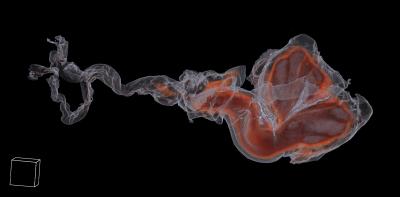Dolphins mating underwater. Image: Ecohotel
Animals have evolved a wide variety of inventive lovemaking strategies, but some are easier for biologists to observe than others. Dolphins, for instance, have labyrinthine internal genitalia, so while there's plenty of footage of these marine mammals mating, the actual "copulatory fit" of the dolphin penis within the vagina is not well understood, according to biologist Dara Orbach, a postdoctoral fellow at Dalhousie University."While it may seem intuitive that the penis fits well into the vagina during copulation, the biomechanics and details of the anatomical fit can be quite complex and have seldom been explored," said Orbach, in a statement. "Whales, dolphins and porpoises have unusual vaginal folds, spirals, and recesses that the penis and sperm must navigate through to successfully fertilize the egg."To untangle these mysteries of cetacean reproductive behavior, Orbach and her colleagues devised a way to study dolphin sex in the laboratory. She presented the team's findings on Sunday at the Experimental Biology 2017 conference, which runs from April 22 to 26 in Chicago.First, the team collected bottlenose dolphins that had died of natural causes, and removed their reproductive tracts. Then the real magic began, as the "flaccid" and "frozen-thawed" dolphin vaginas were stained with iodine and penetrated by penises that had been "mechanically inflated" and treated with formalin to "maintain rigidity," according to Orbach's presentation abstract. The disembodied sets of dolphin junk were scanned independently and the copulatory position with computer tomography. What did we learn from this dolphin necromancy? One insight was that "the tip of the bottlenose dolphin penis navigates around the female's single vaginal fold to achieve successful insemination," according to the abstract. Orbach also said her team's simulated copulation methods could have implications for studying the reproductive dynamics of many animals, which could inform captive breeding programs.Read More: Why Some Animals Try Mating with the Wrong SpeciesBasically, creating a map of the "anatomical landmarks" involved in copulation, to quote Orbach, gives breeders a better understanding of how to stimulate those regions during artificial insemination to enhance the probability of fertilization. By analyzing which unique penetration angles lead to conception, researchers can predict or recommend the best alignments for successful breeding.The secrets of dolphin fertilization are being unraveled by innovative simulated sex techniques in laboratories around the world. It's a weird day job, but our understanding of the unique evolutionary biology of marine mammals, our distant cousins, depends on it.Subscribe to Science Solved It , Motherboard's new show about the greatest mysteries that were solved by science.
What did we learn from this dolphin necromancy? One insight was that "the tip of the bottlenose dolphin penis navigates around the female's single vaginal fold to achieve successful insemination," according to the abstract. Orbach also said her team's simulated copulation methods could have implications for studying the reproductive dynamics of many animals, which could inform captive breeding programs.Read More: Why Some Animals Try Mating with the Wrong SpeciesBasically, creating a map of the "anatomical landmarks" involved in copulation, to quote Orbach, gives breeders a better understanding of how to stimulate those regions during artificial insemination to enhance the probability of fertilization. By analyzing which unique penetration angles lead to conception, researchers can predict or recommend the best alignments for successful breeding.The secrets of dolphin fertilization are being unraveled by innovative simulated sex techniques in laboratories around the world. It's a weird day job, but our understanding of the unique evolutionary biology of marine mammals, our distant cousins, depends on it.Subscribe to Science Solved It , Motherboard's new show about the greatest mysteries that were solved by science.
Advertisement

